Characterization and Evaluation of Rapamycin-Loaded Nano-Micelle Ophthalmic Solution
Abstract
1. Introduction
2. Materials and Methods
2.1. Chemical Reagents
2.2. Preparation of RAPA Micelles
2.3. Properties of the RAPA Micelles
2.3.1. Entrapment Efficiency
2.3.2. Micelle Size and Zeta Potential
2.4. Physicochemical Characterization of the Optimal RAPA Micelles
2.4.1. Transmission Electron Microscopy (TEM)
2.4.2. Differential Scanning Calorimetry (DSC)
2.4.3. Infrared (IR) Spectrophotometry
2.4.4. X-Ray Diffraction (XRD)
2.5. Storage Stability Test
2.6. Cytocompatibility Evaluation
2.7. In Vitro Parallel Artificial Membrane Permeability Assay
2.8. Animal Experiments
2.9. In Vivo Anti-Inflammatory Activity Evaluation
2.10. Transcriptome Sequencing
2.11. Statistical Analysis
3. Results
3.1. Preparation and Characterization of RAPA Micelles
3.2. Outline of RAPA-NM with PVCL-PVA-PEG/RAPA Weight Ratio of 18:1
3.3. Physicochemical Properties of the RAPA Micelles
3.4. Storage Stability
3.5. Cytocompatibility Evaluation
3.6. In Vitro PAMPA
3.7. Systemically Understanding the Mechanism of RAPA-NM in Inhibiting Corneal Allograft Rejection
4. Discussion
Supplementary Materials
Author Contributions
Funding
Institutional Review Board Statement
Informed Consent Statement
Data Availability Statement
Conflicts of Interest
References
- Akimova, T.; Kamath, B.M.; Goebel, J.W.; Meyers, K.E.C.; Rand, E.B.; Hawkins, A.; Levine, M.H.; Bucuvalas, J.C.; Hancock, W.W. Differing effects of rapamycin or calcineurin inhibitor on T-regulatory cells in pediatric liver and kidney transplant recipients. Am. J. Transplant. 2012, 12, 3449–3461. [Google Scholar] [CrossRef]
- Rossano, J.W.; Jefferies, J.L.; Pahl, E.; Naftel, D.C.; Pruitt, E.; Lupton, K.; Dreyer, W.J.; Chinnock, R.; Boyle, G.; Mahle, W.T.; et al. Use of sirolimus in pediatric heart transplant patients: A multi-institutional study from the Pediatric Heart Transplant Study Group. J. Heart Lung Transplant. 2017, 36, 427–433. [Google Scholar] [CrossRef]
- Rupertus, K.; Dahlem, C.; Menger, M.D.; Schilling, M.K.; Kollmar, O. Rapamycin inhibits hepatectomy-induced stimulation of metastatic tumor growth by reduction of angiogenesis, microvascular blood perfusion, and tumor cell proliferation. Ann. Surg. Oncol. 2009, 16, 2629–2637. [Google Scholar] [CrossRef]
- Kwon, S.; Ban, K.; Hong, Y.K.; Sung, J.S.; Choi, I. PROX1, a key mediator of the anti-proliferative effect of rapamycin on hepatocellular carcinoma cells. Cells 2022, 11, 446. [Google Scholar] [CrossRef]
- Tong, Y.; Zhang, J.; Wang, L.; Wang, Q.; Huang, H.; Chen, X.; Zhang, Q.; Li, H.; Sun, N.; Liu, G.; et al. Hyper-synergistic antifungal activity of rapamycin and peptide-like compounds against Candida albicans orthogonally via Tor1 kinase. ACS Infect. Dis. 2021, 7, 2826–2835. [Google Scholar] [CrossRef]
- Martinez-Miguel, V.E.; Lujan, C.; Espie-Caullet, T.; Martinez-Martinez, D.; Moore, S.; Backes, C.; Gonzalez, S.; Galimov, E.R.; Brown, A.E.X.; Halic, M.; et al. Increased fidelity of protein synthesis extends lifespan. Cell Metab. 2021, 33, 2288–2300.e12. [Google Scholar] [CrossRef]
- Xia, W.; Li, C.; Chen, Q.; Huang, J.; Zhao, Z.; Liu, P.; Xu, K.; Li, L.; Hu, F.; Zhang, S.; et al. Intravenous route to choroidal neovascularization by macrophage-disguised nanocarriers for mTOR modulation. Acta Pharm. Sin. B 2022, 12, 2506–2521. [Google Scholar] [CrossRef]
- Kaarniranta, K.; Blasiak, J.; Liton, P.; Boulton, M.; Klionsky, D.J.; Sinha, D. Autophagy in age-related macular degeneration. Autophagy 2022, 1–13. [Google Scholar] [CrossRef]
- Merrill, P.T.; Clark, W.L.; Banker, A.S.; Fardeau, C.; Franco, P.; LeHoang, P.; Ohno, S.; Rathinam, S.R.; Ali, Y.; Mudumba, S.; et al. Efficacy and safety of intravitreal sirolimus for noninfectious uveitis of the posterior segment: Results from the sirolimus study assessing double-masked uveitis treatment (SAKURA) program. Ophthalmology 2020, 127, 1405–1415. [Google Scholar] [CrossRef]
- Dugel, P.U.; Blumenkranz, M.S.; Haller, J.A.; Williams, G.A.; Solley, W.A.; Kleinman, D.M.; Naor, J. A randomized, dose-escalation study of subconjunctival and intravitreal injections of sirolimus in patients with diabetic macular edema. Ophthalmology 2012, 119, 124–131. [Google Scholar] [CrossRef]
- Shah, M.; Edman, M.C.; Reddy Janga, S.; Yarber, F.; Meng, Z.; Klinngam, W.; Bushman, J.; Ma, T.; Liu, S.; Louie, S.; et al. Rapamycin eye drops suppress lacrimal gland inflammation in a murine model of Sjögren’s syndrome. Investig. Ophthalmol. Vis. Sci. 2017, 58, 372–385. [Google Scholar] [CrossRef]
- Khan, K.U.; Minhas, M.U.; Badshah, S.F.; Suhail, M.; Ahmad, A.; Ijaz, S. Overview of nanoparticulate strategies for solubility enhancement of poorly soluble drugs. Life Sci. 2022, 291, 120301. [Google Scholar] [CrossRef]
- Beltzig, L.; Frumkina, A.; Schwarzenbach, C.; Kaina, B. Cytotoxic, genotoxic and senolytic potential of native and micellar curcumin. Nutrients 2021, 13, 2385. [Google Scholar] [CrossRef]
- Carlson, L.J.; Cote, B.; Alani, A.W.; Rao, D.A. Polymeric micellar co-delivery of resveratrol and curcumin to mitigate in vitro doxorubicin-induced cardiotoxicity. J. Pharm. Sci. 2014, 103, 2315–2322. [Google Scholar] [CrossRef]
- Yusuf, O.; Ali, R.; Alomrani, A.H.; Alshamsan, A.; Alshememry, A.K.; Almalik, A.M.; Lavasanifar, A.; Binkhathlan, Z. Design and development of D-α-tocopheryl polyethylene glycol succinate-block-poly(ε-caprolactone) (TPGS-b-PCL) nanocarriers for solubilization and controlled release of paclitaxel. Molecules 2021, 26, 2690. [Google Scholar] [CrossRef]
- Dave, R.S.; Goostrey, T.C.; Ziolkowska, M.; Czerny-Holownia, S.; Hoare, T.; Sheardown, H. Ocular drug delivery to the anterior segment using nanocarriers: A mucoadhesive/mucopenetrative perspective. J. Control. Release 2021, 336, 71–88. [Google Scholar] [CrossRef]
- Kimna, C.; Winkeljann, B.; Hoffmeister, J.; Lieleg, O. Biopolymer-based nanoparticles with tunable mucoadhesivity efficiently deliver therapeutics across the corneal barrier. Mater. Sci. Eng. C 2021, 121, 111890. [Google Scholar] [CrossRef]
- Ghezzi, M.; Ferraboschi, I.; Delledonne, A.; Pescina, S.; Padula, C.; Santi, P.; Sissa, C.; Terenziani, F.; Nicoli, S. Cyclosporine-loaded micelles for ocular delivery: Investigating the penetration mechanisms. J. Control. Release 2022, 349, 744–755. [Google Scholar] [CrossRef]
- Wei, C.; Wang, Y.; Ma, L.; Wang, X.; Chi, H.; Zhang, S.; Liu, T.; Li, Z.; Xiang, D.; Dong, Y.; et al. Rapamycin nano-micelle ophthalmic solution reduces corneal allograft rejection by potentiating myeloid-derived suppressor cells’ function. Front. Immunol. 2018, 9, 2283. [Google Scholar] [CrossRef]
- Wei, C.; Ma, L.; Xiang, D.; Huang, C.; Wang, H.; Wang, X.; Zhang, S.; Qi, X.; Shi, W.; Gao, H. Enhanced autophagy alleviated corneal allograft rejection via inhibiting NLRP3 inflammasome activity. Am. J. Transplant. 2022, 22, 1362–1371. [Google Scholar] [CrossRef]
- Wang, Y.; Wang, C.; Gong, C.; Wang, Y.; Guo, G.; Luo, F.; Qian, Z. Polysorbate 80 coated poly (ε-caprolactone)-poly (ethylene glycol)-poly (e-caprolactone) micelles for paclitaxel delivery. Int. J. Pharm. 2012, 434, 1–8. [Google Scholar] [CrossRef] [PubMed]
- Linares-Alba, M.A.; Gómez-Guajardo, M.B.; Fonzar, J.F.; Brooks, D.E.; García-Sánchez, G.A.; Bernad-Bernad, M.J. Preformulation studies of a liposomal formulation containing sirolimus for the treatment of dry eye disease. J. Ocul. Pharmacol. Ther. 2016, 32, 11–22. [Google Scholar] [CrossRef] [PubMed]
- Sun, F.; Zheng, Z.; Lan, J.; Li, X.; Li, M.; Song, K.; Wu, X. New micelle myricetin formulation for ocular delivery: Improved stability, solubility, and ocular anti-inflammatory treatment. Drug Deliv. 2019, 26, 575–585. [Google Scholar] [CrossRef] [PubMed]
- Li, M.; Xin, M.; Guo, C.; Lin, G.; Wu, X. New nanomicelle curcumin formulation for ocular delivery: Improved stability, solubility, and ocular anti-inflammatory treatment. Drug Dev. Ind. Pharm. 2017, 43, 1846–1857. [Google Scholar] [CrossRef]
- Wu, Q.; Liu, D.; Zhang, X.; Wang, D.; DongYe, M.; Chen, W.; Lin, D.; Zhu, F.; Chen, W.; Lin, H. Development and effects of tacrolimus-loaded nanoparticles on the inhibition of corneal allograft rejection. Drug Deliv. 2019, 26, 290–299. [Google Scholar] [CrossRef]
- Hou, Y.; Zhang, F.; Lan, J.; Sun, F.; Li, J.; Li, M.; Song, K.; Wu, X. Ultra-small micelles based on polyoxyl 15 hydroxystearate for ocular delivery of myricetin: Optimization, in vitro, and in vivo evaluation. Drug Deliv. 2019, 26, 158–167. [Google Scholar] [CrossRef]
- Račić, A.; Čalija, B.; Milić, J.; Jurišić Dukovski, B.; Lovrić, J.; Dobričić, V.; Micov, A.; Vuković, M.; Stepanović-Petrović, R.; Krajišnik, D. Formulation of olopatadine hydrochloride viscous eye drops—Physicochemical, biopharmaceutical and efficacy assessment using in vitro and in vivo approaches. Eur. J. Pharm. Sci. 2021, 166, 105906. [Google Scholar] [CrossRef]
- Berben, P.; Bauer-Brandl, A.; Brandl, M.; Faller, B.; Flaten, G.E.; Jacobsen, A.C.; Brouwers, J.; Augustijns, P. Drug permeability profiling using cell-free permeation tools: Overview and applications. Eur. J. Pharm. Sci. 2018, 119, 219–233. [Google Scholar] [CrossRef]
- Ruponen, M.; Visti, M.; Ojarinta, R.; Laitinen, R. Permeability of glibenclamide through a PAMPA membrane: The effect of co-amorphization. Eur. J. Pharm. Biopharm. 2018, 129, 247–256. [Google Scholar] [CrossRef]
- Simon, A.; Nghiem, K.S.; Gampe, N.; Garádi, Z.; Boldizsár, I.; Backlund, A.; Darcsi, A.; Nedves, A.N.; Riethmüller, E. Stability study of Alpinia galanga constituents and investigation of their membrane permeability by ChemGPS-NP and the parallel artificial membrane permeability assay. Pharmaceutics 2022, 14, 1967. [Google Scholar] [CrossRef]
- Gao, H.; Shi, W.; Gong, H.; Wang, Y.; Wang, Y.; Xie, L. Establishment of a murine model of chronic corneal allograft dysfunction. Graefe’s Arch. Clin. Exp. Ophthalmol. 2010, 248, 1437–1445. [Google Scholar] [CrossRef] [PubMed]
- He, Y.; Jie, Y.; Wang, B.; Zeng, H.; Zhang, Y.; Pan, Z. Adoptive transfer of donor corneal antigen-specific regulatory T cells can prolong mice corneal grafts survival. Cornea 2010, 29, S25–S31. [Google Scholar] [CrossRef] [PubMed]
- Yu, S.H.; Zhu, K.Y.; Chen, J.; Liu, X.Z.; Xu, P.F.; Zhang, W.; Yan, L.; Guo, H.Z.; Zhu, J. JMJD3 facilitates C/EBPbeta-centered transcriptional program to exert oncorepressor activity in AML. Nat. Commun. 2018, 9, 3369. [Google Scholar] [CrossRef] [PubMed]
- Rouf, M.A.; Vural, I.; Bilensoy, E.; Hincal, A.; Erol, D.D. Rapamycin-cyclodextrin complexation: Improved solubility and dissolution rate. J. Incl. Phenom. Macrocycl. Chem. 2011, 70, 167–175. [Google Scholar] [CrossRef]
- Mehra, N.; Aqil, M.; Sultana, Y. A grafted copolymer-based nanomicelles for topical ocular delivery of everolimus: Formulation, characterization, ex-vivo permeation, in-vitro ocular toxicity, and stability study. Eur. J. Pharm. Sci. 2021, 159, 105735. [Google Scholar] [CrossRef]
- Song, Z.; Zhu, W.; Liu, N.; Yang, F.; Feng, R. Linolenic acid-modified PEG-PCL micelles for curcumin delivery. Int. J. Pharm. 2014, 471, 312–321. [Google Scholar] [CrossRef]
- Chatel, M.A.; Larkin, D.F. Sirolimus and mycophenolate as combination prophylaxis in corneal transplant recipients at high rejection risk. Am. J. Ophthalmol. 2010, 150, 179–184. [Google Scholar] [CrossRef]
- Wang, X.; Wang, W.; Xu, J.; Hong, J.; Le, Q. Pretreatment of rapamycin before allogenic corneal transplant promotes graft survival through increasing CD4 (+) CD25 (+) Foxp3 (+) regulatory T cells. Exp. Clin. Transplant. 2013, 11, 56–62. [Google Scholar] [CrossRef]
- Stanojlovic, S.; Schlickeiser, S.; Appelt, C.; Vogt, K.; Schmitt-Knosalla, I.; Haase, S.; Ritter, T.; Sawitzki, B.; Pleyer, U. Influence of combined treatment of low dose rapamycin and cyclosporin A on corneal allograft survival. Graefe’s Arch. Clin. Exp. Ophthalmol. 2010, 248, 1447–1456. [Google Scholar] [CrossRef]
- Huang, Y.; Venkatraman, S.S.; Boey, F.Y.; Lahti, E.M.; Umashankar, P.R.; Mohanty, M.; Arumugam, S.; Khanolkar, L.; Vaishnav, S. In vitro and in vivo performance of a dual drug-eluting stent (DDES). Biomaterials 2010, 31, 4382–4391. [Google Scholar] [CrossRef]
- Qi, X.; Gao, C.; Yin, C.; Fan, J.; Wu, X.; Di, G.; Wang, J.; Guo, C. Development of quercetin-loaded PVCL-PVA-PEG micelles and application in inhibiting tumor angiogenesis through the PI3K/Akt/VEGF pathway. Toxicol. Appl. Pharmacol. 2022, 437, 115889. [Google Scholar] [CrossRef] [PubMed]
- Koutsoviti, M.; Siamidi, A.; Pavlou, P.; Vlachou, M. Recent advances in the excipients used for modified ocular drug delivery. Materials 2021, 14, 4290. [Google Scholar] [CrossRef] [PubMed]
- Cespi, M.; Casettari, L.; Palmieri, G.F.; Perinelli, D.R.; Bonacucina, G. Rheological characterization of polyvinyl caprolactampolyvinyl acetate-polyethylene glycol graft copolymer (Soluplus®) water dispersions. Colloid. Polym. Sci. 2014, 292, 235–241. [Google Scholar] [CrossRef]
- Zeng, Y.C.; Li, S.; Liu, C.; Gong, T.; Sun, X.; Fu, Y.; Zhang, Z.R. Soluplus micelles for improving the oral bioavailability of scopoletin and their hypouricemic effect in vivo. Acta Pharmacol. Sin. 2017, 38, 424–433. [Google Scholar] [CrossRef] [PubMed]
- Linn, M.; Collnot, E.M.; Djuric, D.; Hempel, K.; Fabian, E.; Kolter, K.; Lehr, C.M. Soluplus® as an effective absorption enhancer of poorly soluble drugs in vitro and in vivo. Eur. J. Pharm. Sci. 2012, 45, 336–343. [Google Scholar] [CrossRef] [PubMed]
- Qi, X.; Gao, C.; Yin, C.; Fan, J.; Wu, X.; Guo, C. Improved anticancer activity of betulinic acid on breast cancer through a grafted copolymer-based micelles system. Drug Deliv. 2021, 28, 1962–1971. [Google Scholar] [CrossRef] [PubMed]
- Moeller, S.; Kegler, R.; Sternberg, K.; Mundkowski, R.G. Influence of sirolimus-loaded nanoparticles on physiological functions of native human polymorphonuclear neutrophils. Nanomedicine. 2012, 8, 1293–1300. [Google Scholar] [CrossRef]
- Zago, A.C.; Raudales, J.C.; Attizzani, G.; Matte, B.S.; Yamamoto, G.I.; Balvedi, J.A.; Nascimento, L.; Kosachenco, B.G.; Centeno, P.R.; Zago, A.J. Local delivery of sirolimus nanoparticles for the treatment of in-stent restenosis. Catheter. Cardiovasc. Interv. 2013, 81, E124–E129. [Google Scholar] [CrossRef]
- Liu, Q.; Zhang, X.; Xue, J.; Chai, J.; Qin, L.; Guan, J.; Zhang, X.; Mao, S. Exploring the intrinsic micro-/nanoparticle size on their in vivo fate after lung delivery. J. Control. Release 2022, 347, 435–448. [Google Scholar] [CrossRef]
- Badr, M.Y.; Halwani, A.A.; Odunze, U.; Eskandarpour, M.; Calder, V.L.; Schätzlein, A.G.; Uchegbu, I.F. The topical ocular delivery of rapamycin to posterior eye tissues and the suppression of retinal inflammatory disease. Int. J. Pharm. 2022, 621, 121755. [Google Scholar] [CrossRef]
- Ogawa, N.; Hiramatsu, T.; Suzuki, R.; Okamoto, R.; Shibagaki, K.; Fujita, K.; Takahashi, C.; Kawashima, Y.; Yamamoto, H. Improvement in the water solubility of drugs with a solid dispersion system by spray drying and hot-melt extrusion with using the amphiphilic polyvinyl caprolactam-polyvinyl acetate-polyethylene glycol graft copolymer and d-mannitol. Eur. J. Pharm. Sci. 2018, 111, 205–214. [Google Scholar] [CrossRef] [PubMed]
- Gao, H.; Huang, T.; Pan, Z.; Wu, J.; Xu, J.; Hong, J.; Chen, W.; Wu, H.; Kang, Q.; Zhu, L.; et al. Survey report on keratoplasty in China: A 5-year review from 2014 to 2018. PLoS ONE 2020, 15, e0239939. [Google Scholar] [CrossRef] [PubMed]
- Wei, C.; Ma, L.; Chi, H.; Li, L.; Zhang, S.; Yin, W.; Liu, T.; Gao, H.; Shi, W. The NLRP3 inflammasome regulates corneal allograft rejection through enhanced phosphorylation of STAT3. Am. J. Transplant. 2020, 20, 3354–3366. [Google Scholar] [CrossRef] [PubMed]
- Fan, X.; Zhang, J.; Dai, Y.; Shan, K.; Xu, J. Blockage of P2X7R suppresses Th1/Th17-mediated immune responses and corneal allograft rejection via inhibiting NLRP3 inflammasome activation. Exp. Eye Res. 2021, 212, 108792. [Google Scholar] [CrossRef]
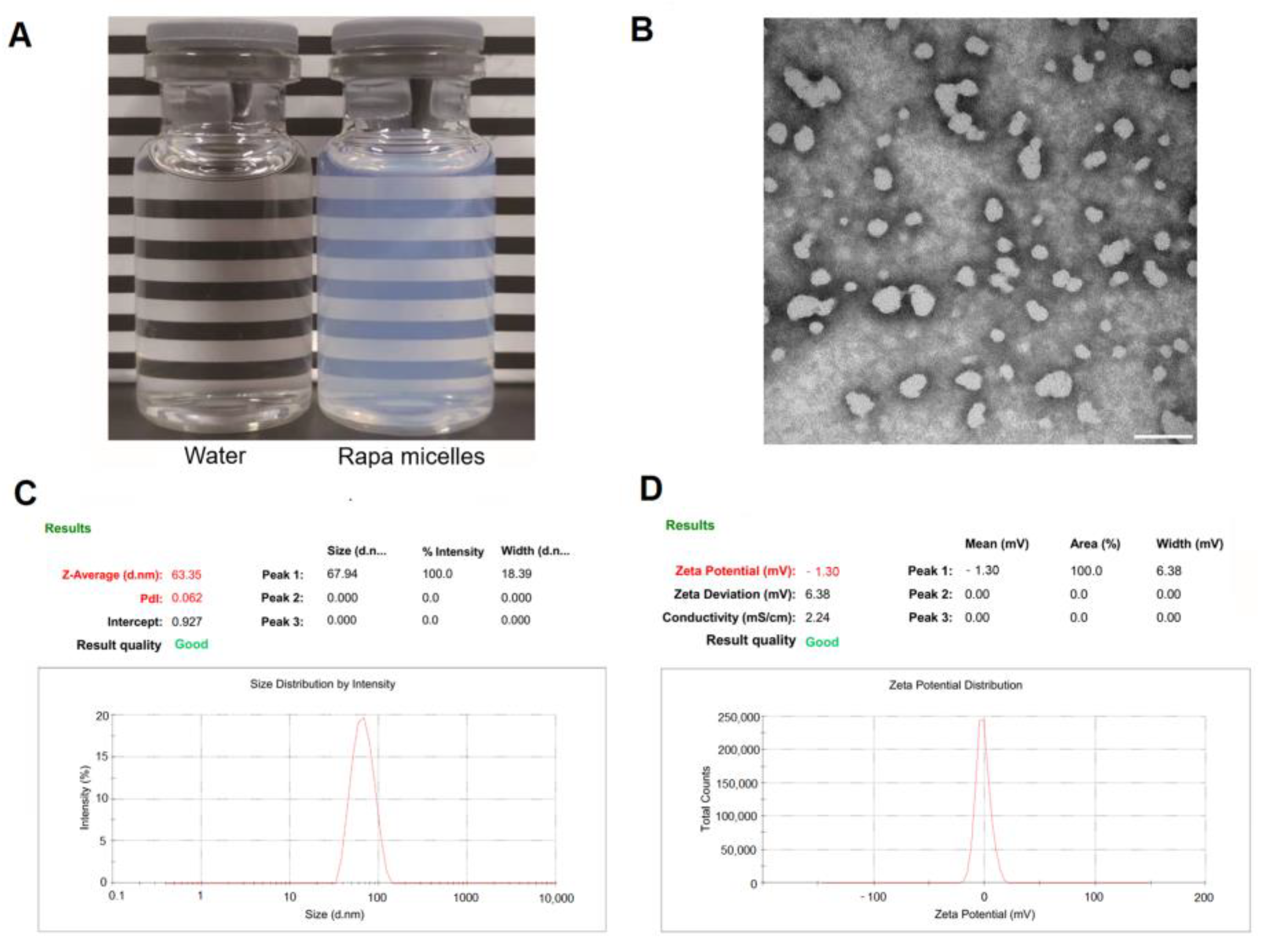

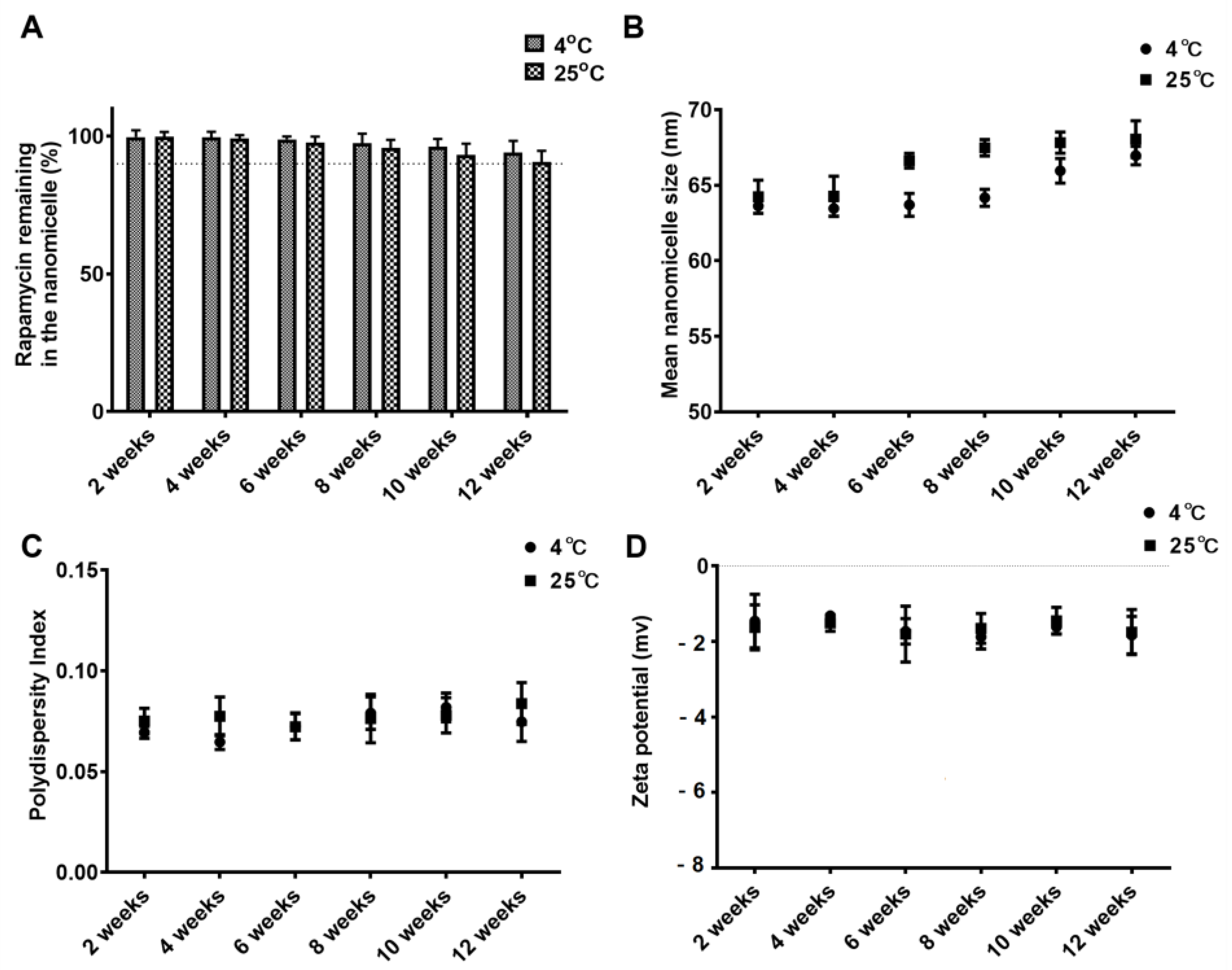
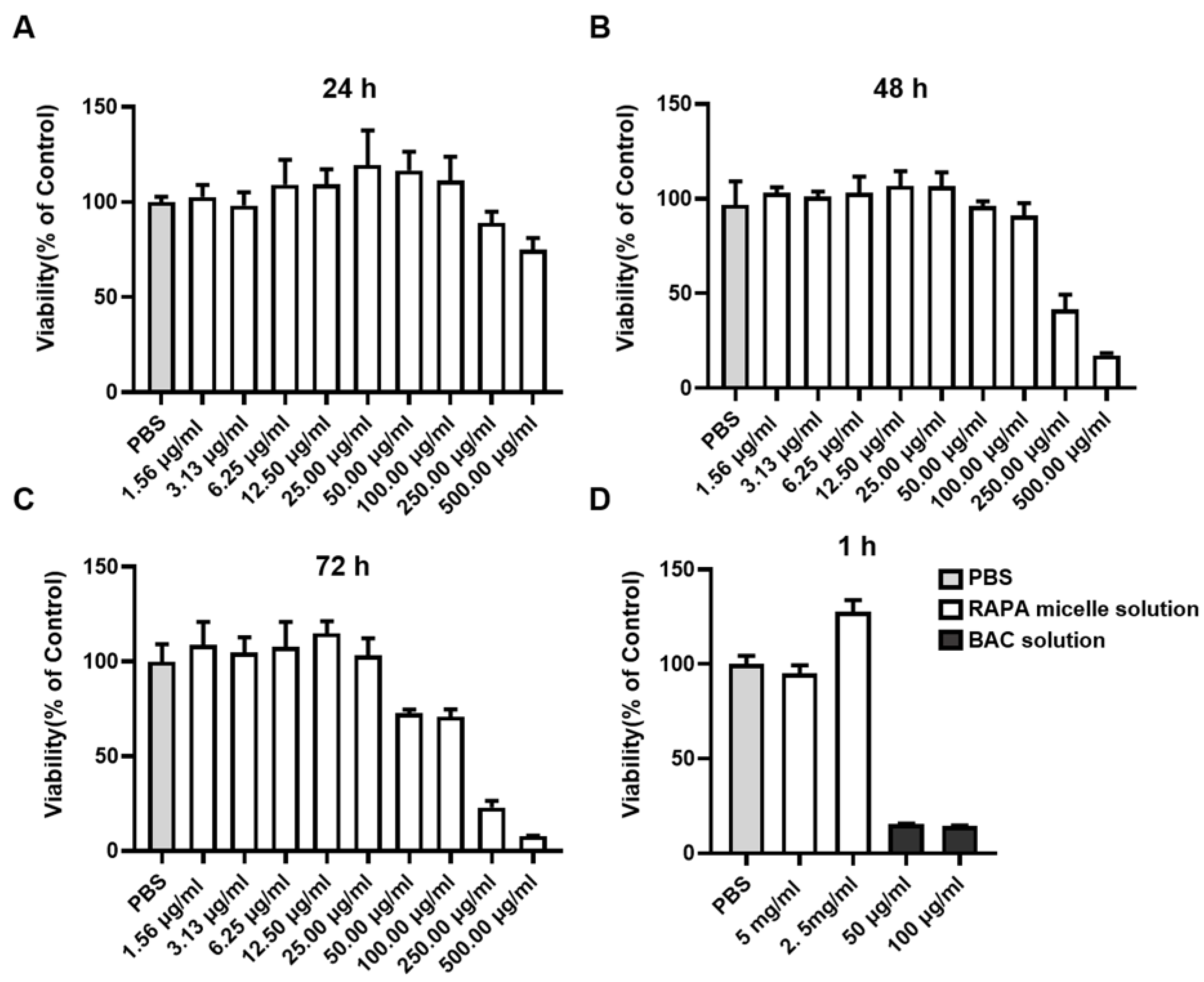
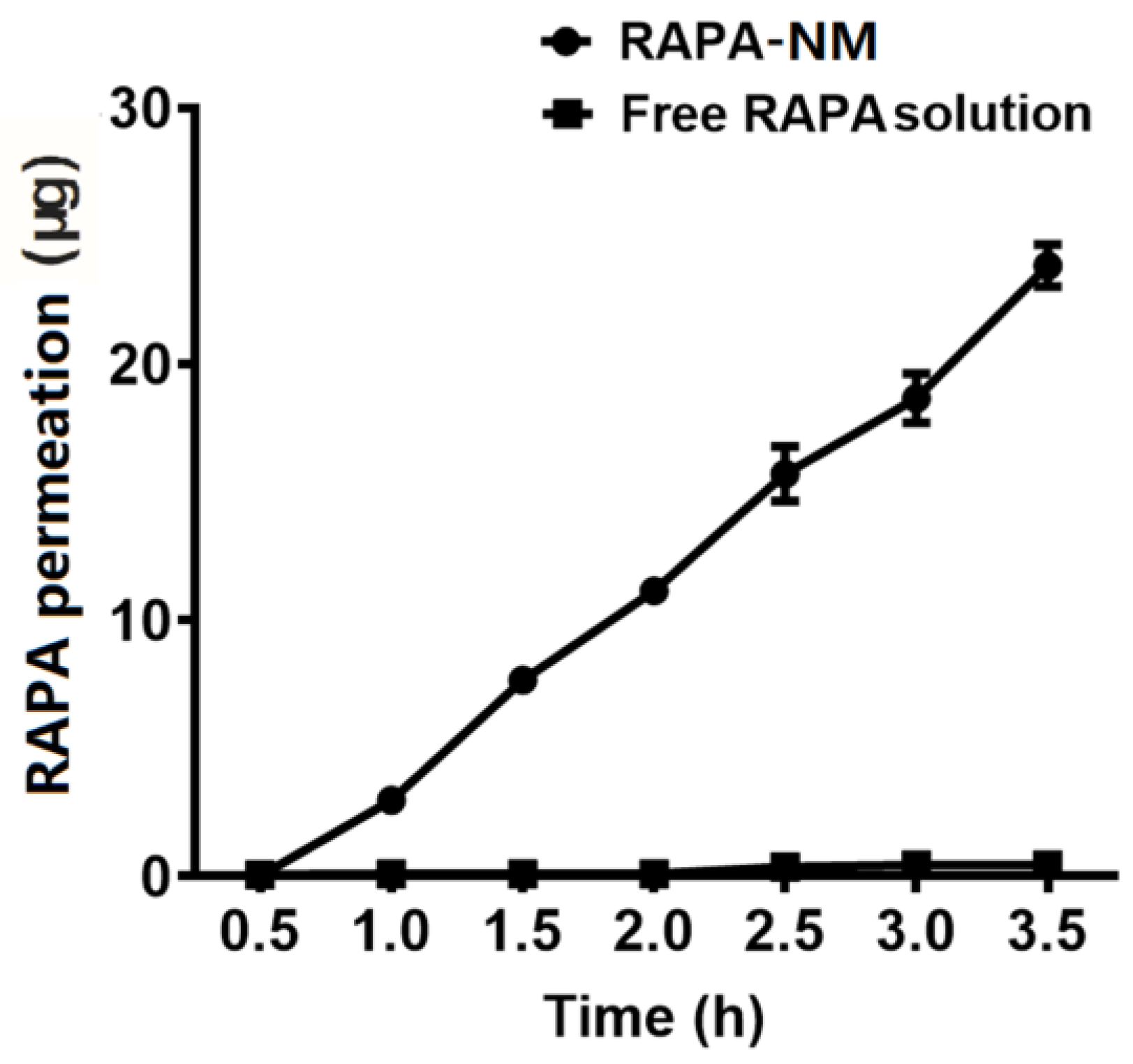

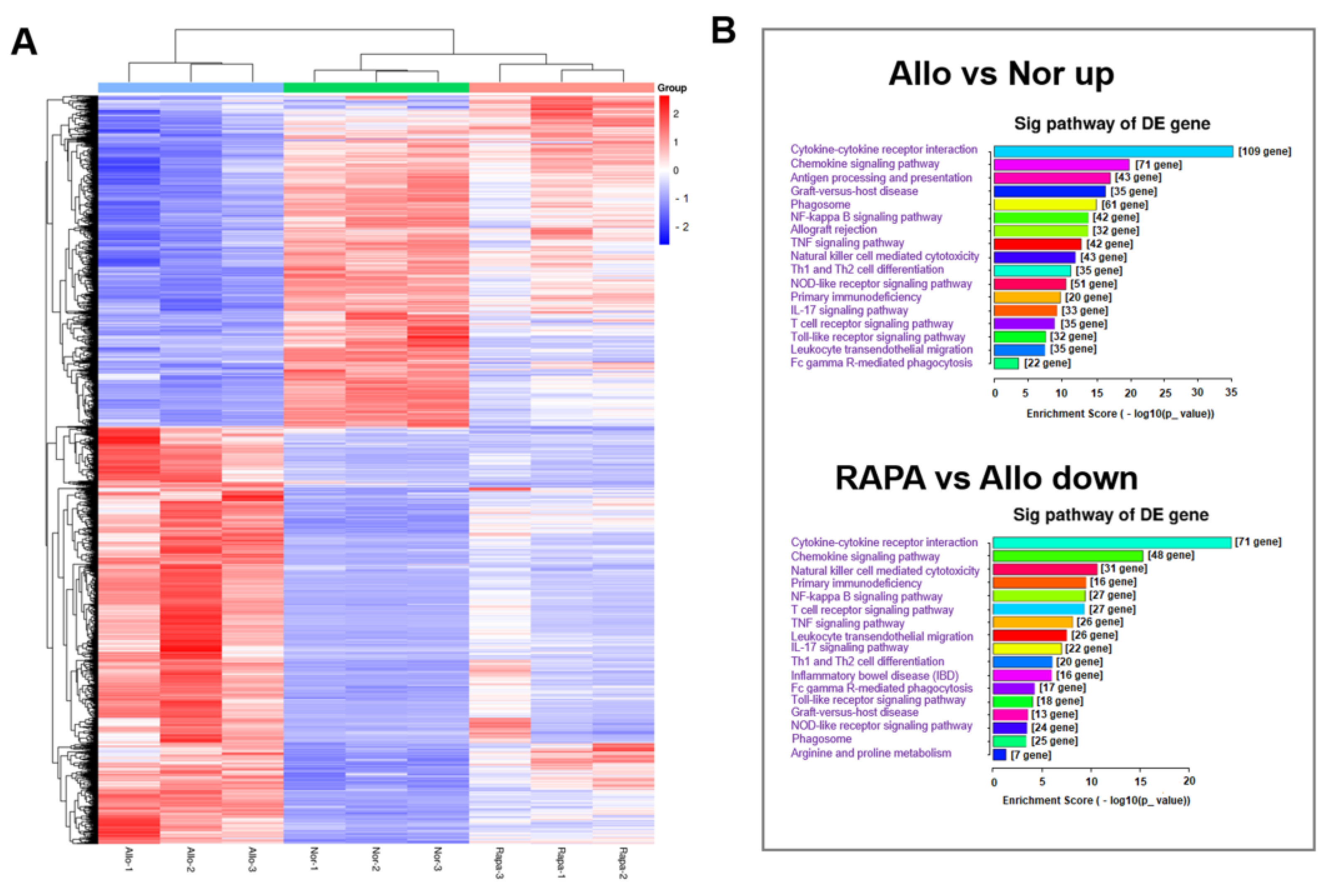
| RAPA-NM | Free RAPA Solution | |||
|---|---|---|---|---|
| Fitted Equation | R2 | Fitted Equation | R2 | |
| Zero order | Q = 7.9206t − 4.4081 | 0.9966 | Q = 0.1498t − 0.0649 | 0.8363 |
| First order | Ln(100 − Q) = − 0.09t + 4.6598 | 0.993 | Ln(100 − Q) = − 0.0015t + 4.6058 | 0.8365 |
| Higuchi | Q = 20.446t1/2 − 16.403 | 0.8992 | Q = 0.3763t1/2 − 0.2776 | 0.7730 |
| Korsmeyer–Peppas | LgQ = 3.1718Lgt − 0.0474 | 0.9622 | LgQ = 1.0583Lgt − 0.9925 | 0.7684 |
| Hixson–Crowell | (100 − Q)1/3 = − 0.1334t + 4.7203 | 0.7770 | (100 − Q)1/3 = − 0.0023t + 4.6426 | 0.8365 |
Disclaimer/Publisher’s Note: The statements, opinions and data contained in all publications are solely those of the individual author(s) and contributor(s) and not of MDPI and/or the editor(s). MDPI and/or the editor(s) disclaim responsibility for any injury to people or property resulting from any ideas, methods, instructions or products referred to in the content. |
© 2023 by the authors. Licensee MDPI, Basel, Switzerland. This article is an open access article distributed under the terms and conditions of the Creative Commons Attribution (CC BY) license (https://creativecommons.org/licenses/by/4.0/).
Share and Cite
Zhang, T.; Wei, C.; Wu, X.; Zhang, S.; Duan, F.; Qi, X.; Shi, W.; Gao, H. Characterization and Evaluation of Rapamycin-Loaded Nano-Micelle Ophthalmic Solution. J. Funct. Biomater. 2023, 14, 49. https://doi.org/10.3390/jfb14010049
Zhang T, Wei C, Wu X, Zhang S, Duan F, Qi X, Shi W, Gao H. Characterization and Evaluation of Rapamycin-Loaded Nano-Micelle Ophthalmic Solution. Journal of Functional Biomaterials. 2023; 14(1):49. https://doi.org/10.3390/jfb14010049
Chicago/Turabian StyleZhang, Ting, Chao Wei, Xianggen Wu, Sai Zhang, Fangnan Duan, Xiaolin Qi, Weiyun Shi, and Hua Gao. 2023. "Characterization and Evaluation of Rapamycin-Loaded Nano-Micelle Ophthalmic Solution" Journal of Functional Biomaterials 14, no. 1: 49. https://doi.org/10.3390/jfb14010049
APA StyleZhang, T., Wei, C., Wu, X., Zhang, S., Duan, F., Qi, X., Shi, W., & Gao, H. (2023). Characterization and Evaluation of Rapamycin-Loaded Nano-Micelle Ophthalmic Solution. Journal of Functional Biomaterials, 14(1), 49. https://doi.org/10.3390/jfb14010049







